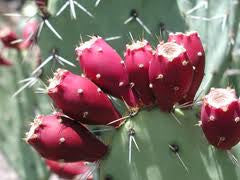5 Weird Fruits You Should Try
Here are five metabolic superstar fruits you probably haven’t tried—but you definitely should.
Kumquat
Taste it: Kumquats look like little grape-sized oranges. Just munch them whole, like grapes—sweet skin, tart pulp, teeny seeds, and all. Or slice them into winter salads, with bitter greens like endive and radicchio.
Body benefits: Kumquats are crammed with antioxidants—especially metabolism-stoking vitamin C—and fiber to stabilize your blood sugar. They’re a good source of potassium and vitamin A, too.
Prickly pear
Taste it: Prickly pears are juicy like watermelon, but with a milder melon flavor. They can be green or yellow, but the sweetest dark-red prickly pears are the ones you’ll usually find in the grocery store. Usually, most of the spines will be gone by that point: Just slit the skin from top to bottom and peel it off.
Prickly pears are actually the berries of the nopal cactus. They’re also called cactus pears (or tunas in Spanish).
Body benefits: Packed with fiber and pectin (to stabilize blood sugar), prickly pears are also rich in minerals—especially calcium, magnesium, and potassium.
They’re an antioxidant powerhouse, too. Prickly pears are loaded with vitamin C, plus betalains (found in beets, but hardly anywhere else), carotene, and quercetin.
Ground cherry
Taste it: It looks exactly like a yellow cherry tomato (they’re cousins), but the ground cherry tastes sweet, sort of like pineapple.
Imported from Chile in the 1700s, ground cherries now grow like weeds all over North America. You’ll find them in farmer’s markets in the fall, sometimes called Cape gooseberries or physalis.
Body benefits: Fast metabolisms need lots of vitamins B and C—and ground cherries supply loads of both. They’re also crammed with vitamin A and antioxidant carotenoids.
Cherimoya
Taste it: Mark Twain immortalized the cherimoya as “the most delicious fruit known to men.” This tropical fruit looks like a scaly avocado on the outside. Inside, the fruit is so custardy you can scoop it with a spoon (it’s also called “custard apple”), and luscious like pineapple, banana, and mango all rolled into one.
Body benefits: Succulent cherimoyas are bursting with metabolism-boosting fiber and vitamin C, plus potassium.
Persimmon
Taste it: Persimmons get a bad rap for being lip-puckeringly astringent, but that’s only the unripe ones. Ripe, slightly soft Fuyu persimmons (the tomato-shaped ones) taste sweet and mild, sort of like an apricot. Hachiya (heart-shaped) persimmons are tangier and look like a bag full of jelly when they’re ripe—you’ll be able to scoop the sugary pulp out of the skin with a spoon.
Body benefits: Eat just one persimmon, and you’ll nail down half of your daily vitamin A, plus hefty helpings of three metabolic must-haves—vitamin B6, vitamin C, and fiber.
Here are five metabolic superstar fruits you probably haven’t tried—but you definitely should.
Kumquat
Taste it: Kumquats look like little grape-sized oranges. Just munch them whole, like grapes—sweet skin, tart pulp, teeny seeds, and all. Or slice them into winter salads, with bitter greens like endive and radicchio.
Body benefits: Kumquats are crammed with antioxidants—especially metabolism-stoking vitamin C—and fiber to stabilize your blood sugar. They’re a good source of potassium and vitamin A, too.
Prickly pear
Taste it: Prickly pears are juicy like watermelon, but with a milder melon flavor. They can be green or yellow, but the sweetest dark-red prickly pears are the ones you’ll usually find in the grocery store. Usually, most of the spines will be gone by that point: Just slit the skin from top to bottom and peel it off.
Prickly pears are actually the berries of the nopal cactus. They’re also called cactus pears (or tunas in Spanish).
Body benefits: Packed with fiber and pectin (to stabilize blood sugar), prickly pears are also rich in minerals—especially calcium, magnesium, and potassium.
They’re an antioxidant powerhouse, too. Prickly pears are loaded with vitamin C, plus betalains (found in beets, but hardly anywhere else), carotene, and quercetin.
Ground cherry
Taste it: It looks exactly like a yellow cherry tomato (they’re cousins), but the ground cherry tastes sweet, sort of like pineapple.
Imported from Chile in the 1700s, ground cherries now grow like weeds all over North America. You’ll find them in farmer’s markets in the fall, sometimes called Cape gooseberries or physalis.
Body benefits: Fast metabolisms need lots of vitamins B and C—and ground cherries supply loads of both. They’re also crammed with vitamin A and antioxidant carotenoids.
Cherimoya
Taste it: Mark Twain immortalized the cherimoya as “the most delicious fruit known to men.” This tropical fruit looks like a scaly avocado on the outside. Inside, the fruit is so custardy you can scoop it with a spoon (it’s also called “custard apple”), and luscious like pineapple, banana, and mango all rolled into one.
Body benefits: Succulent cherimoyas are bursting with metabolism-boosting fiber and vitamin C, plus potassium.
Persimmon
Taste it: Persimmons get a bad rap for being lip-puckeringly astringent, but that’s only the unripe ones. Ripe, slightly soft Fuyu persimmons (the tomato-shaped ones) taste sweet and mild, sort of like an apricot. Hachiya (heart-shaped) persimmons are tangier and look like a bag full of jelly when they’re ripe—you’ll be able to scoop the sugary pulp out of the skin with a spoon.
Body benefits: Eat just one persimmon, and you’ll nail down half of your daily vitamin A, plus hefty helpings of three metabolic must-haves—vitamin B6, vitamin C, and fiber.







